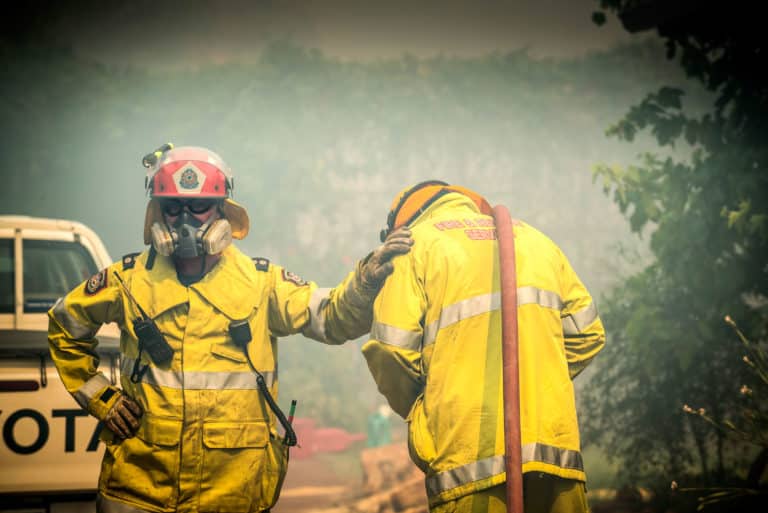
Image by DFES.
The Stepping Stones of Integrating Emotions into Practicing Science
I was a scientist just a few years out of graduate school when I had a career-altering experience speaking with a man in tears at a community workshop.
A large cluster of wildfires had burned through his small, close-knit northern California town, and many residents were forced to evacuate their homes. They were worried that their properties would be unprotected in the time they had to stay away: firefighting resources were strained due to additional wildfires in other parts of the state. Emotions ran high for everyone as my colleagues and I presented our work on how houses burn during wildfires.
During the workshop, we talked about the controversial “stay or go” policy. Instead of being evacuated, families would be trained and have the option to stay and protect their homes during wildfires since firefighters may not always have the resources to worry about each individual property. This idea of staying with your house as a wildfire rages through can raise a lot of literal life-and-death feelings — as well as intrigue — for communities and firefighters alike. And, here we were, talking to people who had just lived the dilemmas of our research topic. While some were sad, angry, afraid, and anxious about having had to evacuate, others were just grateful that the damage to their property had not been worse.
This kind, gentle man shared with me how powerless he felt when he left behind his home and irreplaceable belongings after many exhausting hours spent moving equipment and farm animals. Listening to his story was the first time I became acutely aware that the intellectual rigors of my scientific training did not prepare me for the strong bouts of emotions that come with research that has immediate meaning in people’s lives. Speaking with him inspired a decade of work (so far) to understand how science and emotion can be integrated — for myself and others.

The precarious balance between subjectivity and objectivity in science
Scientists are encouraged to be as objective as possible by adhering to the scientific method. Yet, that objectivity is often challenged by the subjectivity that comes with being human, particularly for those who work on complex and sometimes contentious issues that may bring up a lot of feelings. Rationality and objectivity — often seen as opposites of emotionality — are idealized in modern science, and there is a deep-seated fear that moving away from that norm will ruin the profession.
On the other hand, not recognizing the emotional context of topics such as climate change, species loss, or natural disasters can be both stifling for individuals and prevent scientists from connecting with affected communities on these kinds of issues. It can even become dangerous when we intellectually distance ourselves from the emotional implications of our research by ignoring or dismissing feeling-based reactions. It can cause us to miss out on the valuable role emotions can play as a source of information in our work.
While emotion in scientific research and practice is not often broadly discussed, there seems to be more active conversation surrounding this topic in climate science. Historian Naomi Oreskes argues that scientists should express more alarm about climate change. She recalls a conference presentation where an audience member stood up and said, “You are telling us that we have a very serious problem, but you don’t sound at all worried. You don’t even sound upset!” Oreskes argues that expressing concern would help convey the seriousness of the issue, that it’s difficult to get excited about something when the experts themselves seem dispassionate. Author and environmental communicator George Marshall believes that when it comes to climate change, the unwillingness of scientists to show emotion has been counterproductive in engaging the public.
Some people are also concerned that stifling emotion could take a toll on scientists who work on difficult issues. Madeleine Thomas recently wrote an article geared towards scientists on “climate depression.” In addition, communicator Joe Duggan started a project titled “Is this how you feel?” that contains letters from climate scientists who expressed a wide variety of emotions — ranging from anger to optimism — about their research.
It’s not just climate scientists who experience deep feelings about their work. Pat Thomson, a professor of education at the University of Nottingham, gets angered while studying poverty and inequality in education. Raul Pacheco-Verchago, a professor at the Centre for Economic Research and Teaching, gets very emotionally involved in his work on water and sanitation, tweeting:
I have no problem admitting that my research is emotionally fueled. Poverty, lack of access to sanitation, inequality all get me.
— Dr Raul Pacheco-Vega (@raulpacheco) July 21, 2013
I have written on my own deeply-felt experience “live tweeting a drought” as I work closely on the slow-moving natural disaster happening in California.
Incorporating emotions into the practice of science
When we recognize and allow for the diverse range of emotions that can arise in practicing science, a key question emerges: what, if anything, should we do about it? Climate change, scholars, and communicators like Oreskes, Marshall, and Duggan hope that scientists will convey the seriousness of key issues and get others to act by expressing their emotions. Psychologists and others are more focused on providing support and resources, like therapy and mindfulness, for researchers and practitioners.
For me, the questions around science and emotion are more exploratory. I initially became curious about how emotions came into play with my work, inspired by interactions like the one I had with the man who had been evacuated. Over time, I began to focus on when it is or isn’t helpful to share them. These days, I am particularly interested in what happens when my emotions intersect with others, whether they be scientists or members of the many communities I interact with.
Since emotion is not commonly discussed in the natural sciences, I sometimes turn to other fields like medicine and law where practitioners are better trained to handle emotional situations with, for example, training in empathy and compassion. I ultimately developed a personal training program by integrating techniques I found helpful from empathy and compassion training in those fields with those from my own experiences. Halfway through grad school, I sought out therapy, a process that has greatly informed both my personal and professional life, and I have also benefited from contemplative practices like yoga and meditation.
Over time, my efforts in understanding the role of emotion in my work have become more intentional. I recently took a six-week Compassion Cultivation Training class with Stanford’s Center for Compassion and Altruism Research and Education. There were several mid-career environmental scientists in a class of about 30, all of whose work had inspired the need to take the class. That course affirmed my belief that being in touch with and expressing my feelings offers an unique opportunity to connect with people around shared human experiences.
I gave a talk a few years ago (with much trepidation) at a professional society meeting on the value of contemplative practices in my work as a science communicator. The positive reception to that talk inspired me to write a short paper on the important themes that emerged in my own work: the value of listening, building relationships, and resolving conflict in community-engaged science. I have seen that one of the biggest challenges by allowing emotions to be expressed in a group setting is that they can simmer into a cauldron of collective emotions: grief, trauma, anger, even joy. Befriending the conflict that can come with this kind of engagement can be hard, but also incredibly useful.
It has been at least a decade since that wildfire workshop where I realized scientific discussions lacking awareness and respect of emotions can be ineffective, counterproductive, and painful. At that time, I stumbled through conversations full of suffering. Today, I can sit with my own and others’ emotions and navigate whatever arises. Integrating emotions into practicing science is not the for the faint of heart, and my methods may not be right for others, but for those of us with the ability, desire, and deep impetus to forge a different path, the stepping stones are there.
This essay was originally published on Hippo Reads and is reprinted here with permission.

